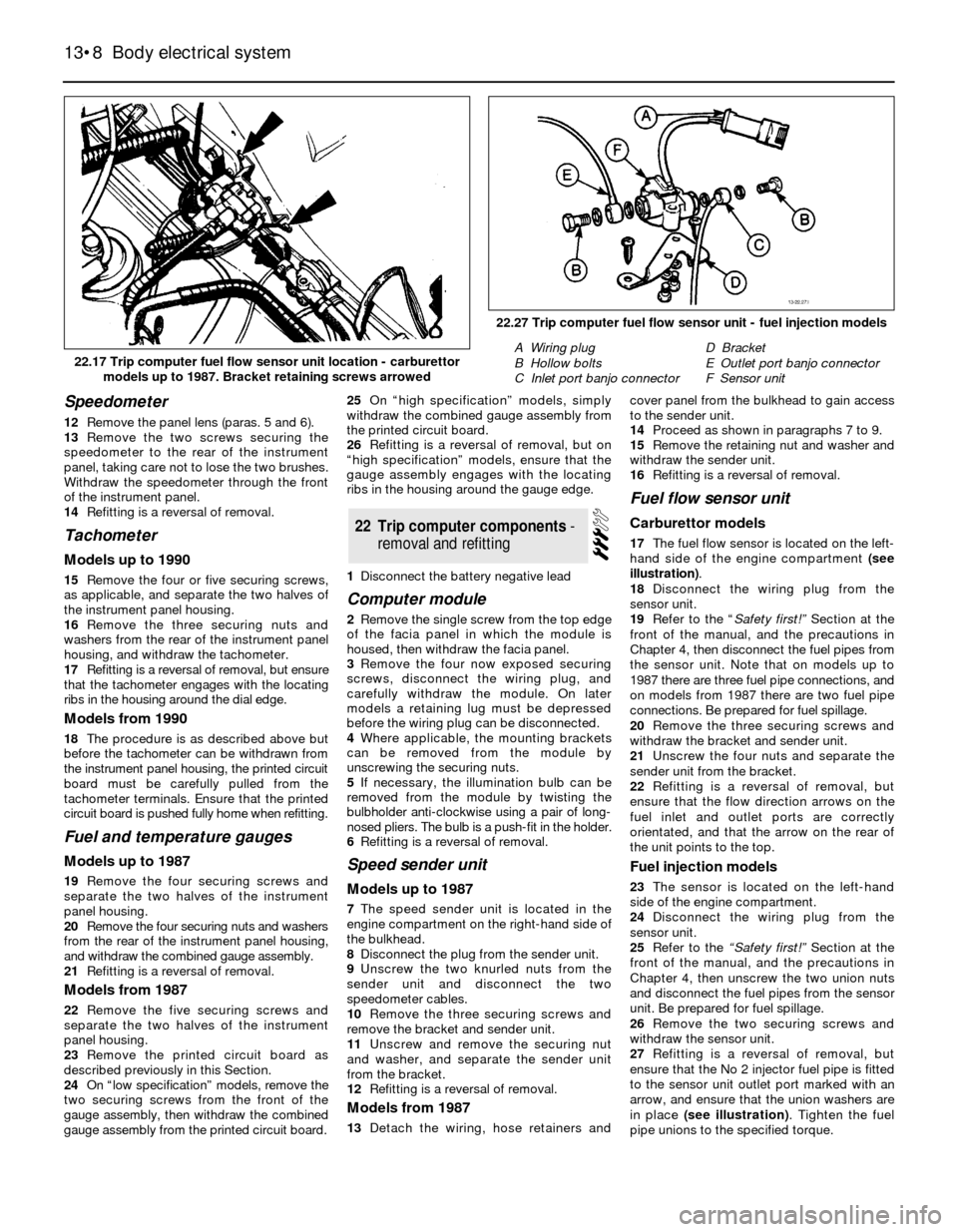Temperature FORD SIERRA 1989 2.G Body Electrical System Workshop Manual
[x] Cancel search | Manufacturer: FORD, Model Year: 1989, Model line: SIERRA, Model: FORD SIERRA 1989 2.GPages: 25, PDF Size: 1.7 MB
Page 8 of 25

Speedometer
12Remove the panel lens (paras. 5 and 6).
13Remove the two screws securing the
speedometer to the rear of the instrument
panel, taking care not to lose the two brushes.
Withdraw the speedometer through the front
of the instrument panel.
14Refitting is a reversal of removal.
Tachometer
Models up to 1990
15Remove the four or five securing screws,
as applicable, and separate the two halves of
the instrument panel housing.
16Remove the three securing nuts and
washers from the rear of the instrument panel
housing, and withdraw the tachometer.
17Refitting is a reversal of removal, but ensure
that the tachometer engages with the locating
ribs in the housing around the dial edge.
Models from 1990
18The procedure is as described above but
before the tachometer can be withdrawn from
the instrument panel housing, the printed circuit
board must be carefully pulled from the
tachometer terminals. Ensure that the printed
circuit board is pushed fully home when refitting.
Fuel and temperature gauges
Models up to 1987
19Remove the four securing screws and
separate the two halves of the instrument
panel housing.
20Remove the four securing nuts and washers
from the rear of the instrument panel housing,
and withdraw the combined gauge assembly.
21Refitting is a reversal of removal.
Models from 1987
22Remove the five securing screws and
separate the two halves of the instrument
panel housing.
23Remove the printed circuit board as
described previously in this Section.
24On “low specification” models, remove the
two securing screws from the front of the
gauge assembly, then withdraw the combined
gauge assembly from the printed circuit board.25On “high specification” models, simply
withdraw the combined gauge assembly from
the printed circuit board.
26Refitting is a reversal of removal, but on
“high specification” models, ensure that the
gauge assembly engages with the locating
ribs in the housing around the gauge edge.
1Disconnect the battery negative lead
Computer module
2Remove the single screw from the top edge
of the facia panel in which the module is
housed, then withdraw the facia panel.
3Remove the four now exposed securing
screws, disconnect the wiring plug, and
carefully withdraw the module. On later
models a retaining lug must be depressed
before the wiring plug can be disconnected.
4Where applicable, the mounting brackets
can be removed from the module by
unscrewing the securing nuts.
5If necessary, the illumination bulb can be
removed from the module by twisting the
bulbholder anti-clockwise using a pair of long-
nosed pliers. The bulb is a push-fit in the holder.
6Refitting is a reversal of removal.
Speed sender unit
Models up to 1987
7The speed sender unit is located in the
engine compartment on the right-hand side of
the bulkhead.
8Disconnect the plug from the sender unit.
9Unscrew the two knurled nuts from the
sender unit and disconnect the two
speedometer cables.
10Remove the three securing screws and
remove the bracket and sender unit.
11Unscrew and remove the securing nut
and washer, and separate the sender unit
from the bracket.
12Refitting is a reversal of removal.
Models from 1987
13Detach the wiring, hose retainers andcover panel from the bulkhead to gain access
to the sender unit.
14Proceed as shown in paragraphs 7 to 9.
15Remove the retaining nut and washer and
withdraw the sender unit.
16Refitting is a reversal of removal.
Fuel flow sensor unit
Carburettor models
17The fuel flow sensor is located on the left-
hand side of the engine compartment (see
illustration).
18Disconnect the wiring plug from the
sensor unit.
19Refer to the “Safety first!” Section at the
front of the manual, and the precautions in
Chapter 4, then disconnect the fuel pipes from
the sensor unit. Note that on models up to
1987 there are three fuel pipe connections, and
on models from 1987 there are two fuel pipe
connections. Be prepared for fuel spillage.
20Remove the three securing screws and
withdraw the bracket and sender unit.
21Unscrew the four nuts and separate the
sender unit from the bracket.
22Refitting is a reversal of removal, but
ensure that the flow direction arrows on the
fuel inlet and outlet ports are correctly
orientated, and that the arrow on the rear of
the unit points to the top.
Fuel injection models
23The sensor is located on the left-hand
side of the engine compartment.
24Disconnect the wiring plug from the
sensor unit.
25Refer to the “Safety first!” Section at the
front of the manual, and the precautions in
Chapter 4, then unscrew the two union nuts
and disconnect the fuel pipes from the sensor
unit. Be prepared for fuel spillage.
26Remove the two securing screws and
withdraw the sensor unit.
27Refitting is a reversal of removal, but
ensure that the No 2 injector fuel pipe is fitted
to the sensor unit outlet port marked with an
arrow, and ensure that the union washers are
in place (see illustration). Tighten the fuel
pipe unions to the specified torque.
22Trip computer components -
removal and refitting
13•8Body electrical system
22.17 Trip computer fuel flow sensor unit location - carburettor
models up to 1987. Bracket retaining screws arrowed
22.27 Trip computer fuel flow sensor unit - fuel injection models
A Wiring plug
B Hollow bolts
C Inlet port banjo connectorD Bracket
E Outlet port banjo connector
F Sensor unit